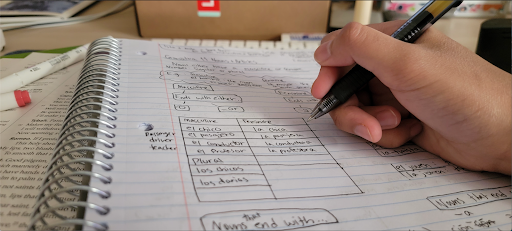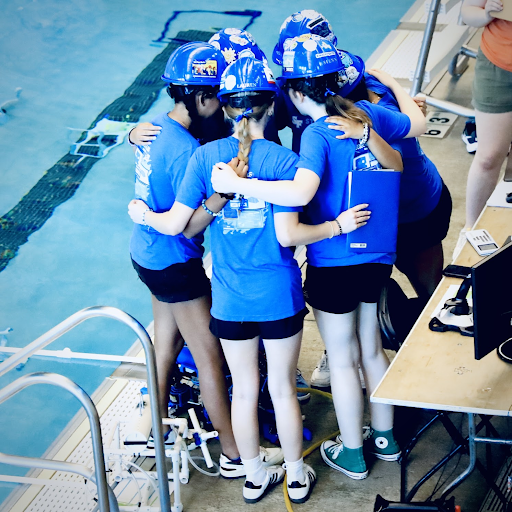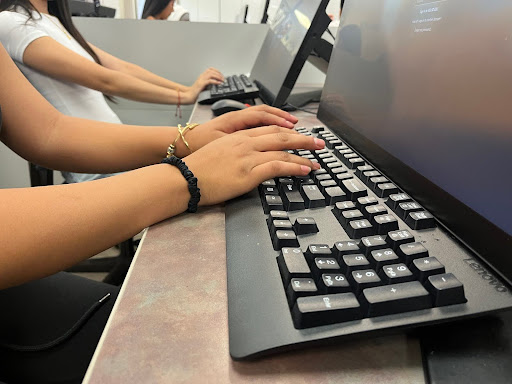Homeschool enrollment skyrocketing after reopening of schools

A student taking notes from a Spanish lecture given at Horizon Charter School. Photo by Saffiya Sheik, Horizon Charter School.
During the COVID-19 pandemic, many students have been forced to stay home and continue their education through online schooling. Currently, with a few exceptions, California prohibits distance learning, and schools have returned to in-person instruction.
Surprisingly, given the outcries of parents wanting schools to reopen, some have chosen to pursue a different path for their children – homeschooling.
Statistics from the Western Placer School District showed an increase of more than 150 students enrolled in homeschooling in 2021-22 compared to 2020-21.
According to the National Home Education Research Institute, approximately 5 million students are homeschooled in the United States.
With parents concerned about COVID-19 and other issues relating to curriculum details and learning environments, more parents are contemplating alternatives to brick-and-mortar schools, including homeschool programs.
Gabriel Robert, one of the guidance counselors at Horizon Charter School, said there are opportunities for students who choose to homeschool.
“Students are not required to be in a brick-and-mortar setting, so they have more time to focus on their academics,” Robert said. “Additionally, the format lends itself to being better able to manage your own course load (and) work at a pace that suits you.”
A flexible homeschool schedule also allows students to take alternative education pathways, such as graduating early or pursuing an associate’s degree – something Sofia Keeler, a student at Horizon Charter School, is doing.
“You can also have the choice of doing an associate’s degree while you’re in high school, which is nice,” Keeler noted. “It’s just an easier way to get even a career with what you’re trying to go for. It’s just really nice to have the opportunity.”
Aneesa Mahmood, a student at California Virtual Academy, said, “So I chose to graduate a whole year early. It’s going to be a lot, but it’s better than me doing a whole year and then having a whole bunch of electives that I don’t really need to take.”
The accessibility of these options leads many to wonder what the future of education might look like going forward.
Sondes Sahli homeschools her daughter through Cottonwood Charter School. She sees positive and negative aspects of the homeschool environment and how it compares to the brick-and-mortar atmosphere.
“If education was a meal, homeschooling is … like you go to an all-you-can-eat place,” Sahli said. “And you have access to everything – you can pick and choose on your own. … But there are risks associated with that.”
And brick-and-mortar schools? In Sahil’s metaphor, they’re like “where you’re going to go to a cafeteria that has one menu per day.”
The accessibility and curriculum details in both systems vary significantly. In brick-and-mortar schools, the pace of instruction remains the same for students in the classroom unless they’re placed in advanced classes or special needs classes.
“It’s kinda like a train going,” Sahli said. “Whether people hop in or hop out, it doesn’t matter. It just keeps on going.” Brick-and-mortar schools are still the most common form of education. However, there are some students who have thrived in homeschool programs because of the change in environment.
“Based on my experience, when I was in public school, I was struggling and teachers were going to hold me back,” said Keeler, the Horizon Charter student. “Once I got homeschooled, my grades immediately went up, and I was able to focus more and truly understand concepts.”
However, brick-and-mortar schools can provide more opportunities for social interactions than the homeschooling environment.
Umaima Atta spent approximately three years at Horizon Charter School before graduating and is now attending the University of California at Davis. She participated in various activities at Horizon, such as the California Scholastic Federation and the STEM club.
“When you’re homeschooling, you can actually go to different events that the school offers to socialize,” Atta noted. “But it’s still not as much as you would interact with people … in public schooling.”
Atta also noted that, while homeschool encourages habits and practices that are beneficial for higher education, the lack of social interactions in homeschool didn’t prepare her for the non-academic side of college life. And she’s not alone.
In brick-and-mortar schools, students are placed in an atmosphere where they are forced to interact with peers, which can lead to meaningful friendships. In homeschooling, students are isolated unless they take the initiative to create friendships through other sources, like extracurriculars.
“I feel it can have a lot of cons because, when you go to college or get a job, you need to know how to interact with people,” said Mahmood, the California Virtual Academy student. “Because if you’re not, it will be very difficult to adjust.”
The lack of social interactions in homeschools is an issue many parents struggle with when discussing the cons and pros with their children.
“It really depends on if the homeschool student is completely by themselves,” Keeler said. “Or if they are in a home with their siblings or if they just have friends, neighbors, really close by.”
Mariem Braiki, a student at Cottonwood Charter School, said, “I think maybe in school you can make closer friends because these are people you’re in contact with more than half of your day. You know, you see these people more than you see your parents.”
Another variable to account for is the responsibility homeschooling places on parents to teach and watch over their children at home, compared to sending kids to brick-and-mortar schools.
“With this way, it’s more demanding on me in terms of time and less demanding on her,” Sahli said.
Both learning arrangements have advantages and disadvantages. Some parents say the essential matter is that schools and parents work together to ensure whatever system they use creates the best attainable results for students. With that information, they say the schools of tomorrow may reflect a fusion of both approaches.
“What I want people to realize is that you can always – no matter what system you find yourself in – you can always find a way to make that system work better for you,” Sahli said. “The future needs to be different from both of these systems because both of these systems have drawbacks.”
Your donation will support the student journalists of Student Education Reporter program. Your contribution will allow us to hire more student journalists to cover education in the Sacramento region.





